Southwark Cathedral - a Brief History

Southwark Cathedral is situated on the south bank of the River Thames close to London Bridge. It is surrounded by railway lines and buildings, including the historic Borough Market. The small churchyard on the south side of the Cathedral is a small oasis of calm and is a favourite lunch-time resting place for local office workers.
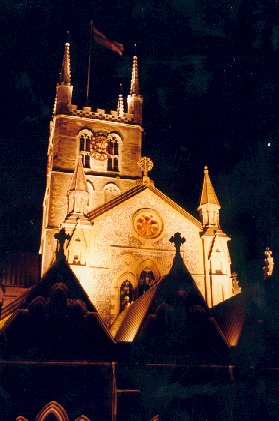
852AD to 1212AD
Southwark Cathedral is situated on a very historic site. It is believed that there has been a church here for over 1000 years. Prior to that there was a Roman villa. Some of its pavement has been incorporated into the floor. In 1977 a well was discovered beneath the choir, it contained a pagan statue believed to have been put there in the fourth century.
St Swithun, Bishop of Winchester 852 - 867, is traditionally believed to have set up a college of priests on the site. The first conclusive proof of a church comes in the Domesday Book of 1086. This records that a monasterium was present during the reign of Edward the Confessor (1042 - 1066) with its own wharf for the profitable unloading of goods brought up the river. After the Norman Conquest control of the church passed to Odo, Bishop Bayeaux and then William de Warenne, Earl of Surrey.
In 1106 a new church, St Mary Overie (over the river), was founded by two knights, William Pont de l'Arche and William Dauncey. This church was served by Regular Canons of St Augustine. Part of their duties was to give relief to the sick and needy. To do this they built a hospital and dedicated it to St Thomas of Canterbury. Now relocated to Lambeth St Thomas's Hospital is still caring for the sick today. Guy's Hospital, still based near the Cathedral, was founded in 1720 to care for patients who could not be accommodated in St Thomas's.
Bishop William Gifford assisted with the building of St Mary Overie. His successor, Henry of Blois, left his mark by building his espiscopal palace, Winchester Palace, two minutes walk from the Cathedral. This building was occupied until 1626, meaning that St Mary Overie could rely on the patronage of the Bishop of Winchester for all that time. Remains of the Palace, including a beautiful rose window, survive to this day.
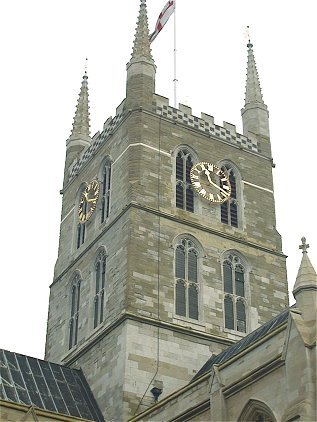
1212AD to 1539AD
In 1212 a disastrous fire hit Southwark, badly damaging the church, priory and hospital. Only a few traces of the Norman church remain today including a doorway in the north aisle of the nave. The Bishop of Winchester, Peter des Roches, oversaw the rebuilding of the priory. It was one of the first examples of Gothic architecture in London and is now the oldest Gothic building in the city. Work rebuilding the choir and retro-choir began around 1215 and the eastern portion was ready for the consecration of a bishop in 1260. By 1273 the choir, sanctuary, aisles, retro-choir, lower tower and western bays of the nave had been completed. There was then a ten year delay in the rebuilding process, presumably due to a lack of money.
In the 1390's disaster struck once more when a second fire caused serious damage to the building. Around 1420, the then Bishop of Winchester, Henry Beaufort, later to become Cardinal, assisted with the rebuilding of the south transept and the completion of the tower. Beaufort's niece, Joan, was married at the Priory to James I of Scotland in 1424.
In 1468 the nave roof collapsed and the vault was rebuilt in wood. Some of the coloured intricate bosses from that ceiling can be seen at the west end and remounted on the ceiling of the tower space. In 1520 Bishop Richard Fox constructed the magnificent altar screen which still separates the Choir from the retro-choir.
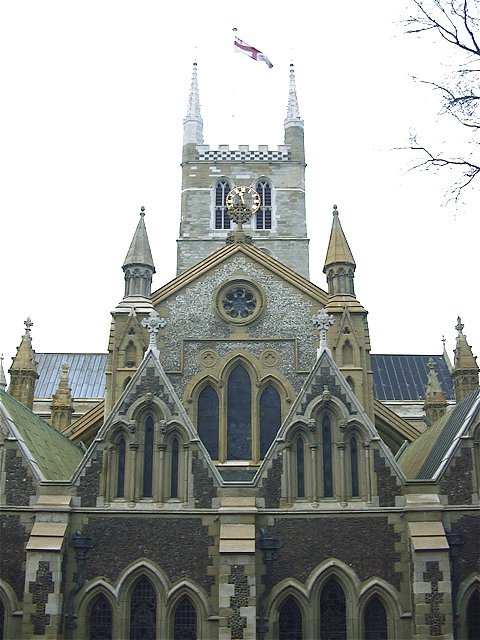
1539AD to 1815AD
The Reformation brought change to the priory church. In 1539 Bartholomew Linsted, the last prior, surrendered the buildings to Henry VIII. He, and the remaining 12 canons received a pension in return. An Act of Parliament made the church a parish church, of St Saviour, Southwark. During the religious persecution of Protestants under Queen Mary, Bishop Stephen Gardiner of Winchester set up his consistory court in the retro-choir. He sentenced seven men to death for heresy, including John Hooper, Bishop of Gloucester and John Rogers of London. A statue of Rogers appears in the altar screen. In 1555 Bishop Gardiner died and the retro-choir was left to fall into disrepair. For a while it was rented out as a bakery and the baker kept pigs in the church. The other monastic buildings were given to Sir Anthony Browne, the King's Master of Horse who built himself a mansion to the north east of the church. Other buildings were used as a Delft pottery and for the manufacture of starch. The kilns where Southwark Delftware was produced can be viewed by visitors in the Archaeological Chamber within Lancelot's Link.
Tired of paying rent for the church to the Crown, the parishioners banded together and bought the church from James I in 1614. They renovated the church and also had the right to appoint their own clergy. St Saviour's was now the parish church of one of London's most colourful areas. The connections with the Elizabethan theatre are reflected by monuments to Edmund Shakespeare, the dramatist's brother, dramatists John Fletcher and Philip Massinger. Half the actors' names which appear on the front page of the Shakespeare First Folio also appear in the church's registers
More repairs occurred in the 18th century and one of the parish's chaplains was the notorious Henry Sacheverell who preached against the Whig government and was deprived of his living only to be re-instated under a Tory administration.
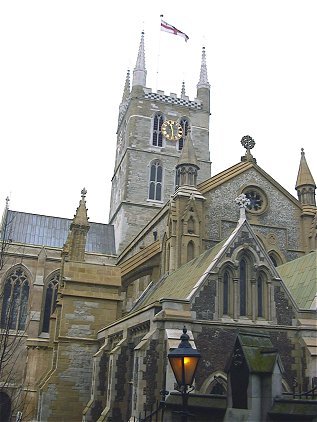
1815AD to 1907AD
Not only was the church in bad repair but it was seriously threatened by the reconstruction of the Old London Bridge, much of which dated back to medieval times. The new approach road to the bridge was within 60 feet of the east end of the church and fifteen feet above the churchyard level. A great controversy developed in the Borough about the future of the church. Some felt it was of architectural importance, others that 'St Saviour's Folly' was a 'damp old monastery' that should be demolished and replaced by a parish church 'more commodious to the needs of the populace'.
After an initial vote to demolish the building completely, the pro-restoration lobby won the day and thanks to the energies of the architect George Gwilt the eastern portion of the choir, aisles and retro-choir were restored. However, the Bishop's Chapel (east of the retro-choir) and the Chapel of St Mary Magdalene (east of the South Transept) were both demolished. The nave was also in a poor condition and in 1831 the roof was removed for safety reasons and it remained open to the elements for seven years. In 1838 a makeshift nave was constructed which caused the great Victorian architect A W Pugin to describe it as ' as vile a preaching place as ever disgraced the 19th century'. In the 1860s the London, Dover and Chatham Railway Company constructed the viaduct that still dominates the cathedral today.
By the end of the nineteenth century the cathedral church at Winchester could not respond to the poor living and working conditions of South London. At first the area was transferred to the Diocese of Rochester. But the Bishop, Anthony Thorold, felt that a new diocese centred at Southwark could cope better with South London's social problems. In 1890 the Prince of Wales laid the foundation stone to the new Nave, which is a very successful and harmonious neighbour to the older part of the building.
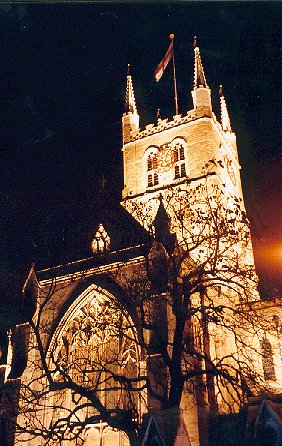
In 1897 St Saviour's became the pro-cathedral of South London. In 1904 an Act of Parliament created the new Diocese of Southwark and in 1905 the church became the Cathedral and Collegiate Church of St Saviour and St Mary Overie. Edward Talbot, the Bishop of Rochester, was enthroned as the first Bishop of Southwark.
The Present
Southwark Cathedral is more than just a beautiful and historic building. It remains a working building and one of its continuing functions is to maintain the worship of God. A Eucharist is celebrated daily on weekdays at lunch time to accommodate those working locally. This service is preceded by Morning Prayer and the working day is completed by Choral Evensong / Evening Prayer. On Mondays, Tuesdays, Thursdays and Fridays during term times the latter service is sung by one or more of the three Cathedral Choirs. On Sundays there is an early Communion at 9am, a Choral Eucharist at 11am, a Choral Evensong at 3pm, and '6.30 at Southwark'. Many services are held for special groups of people, livery companies, the consecration of bishops, World AIDS Days, schools, hospitals and universities.